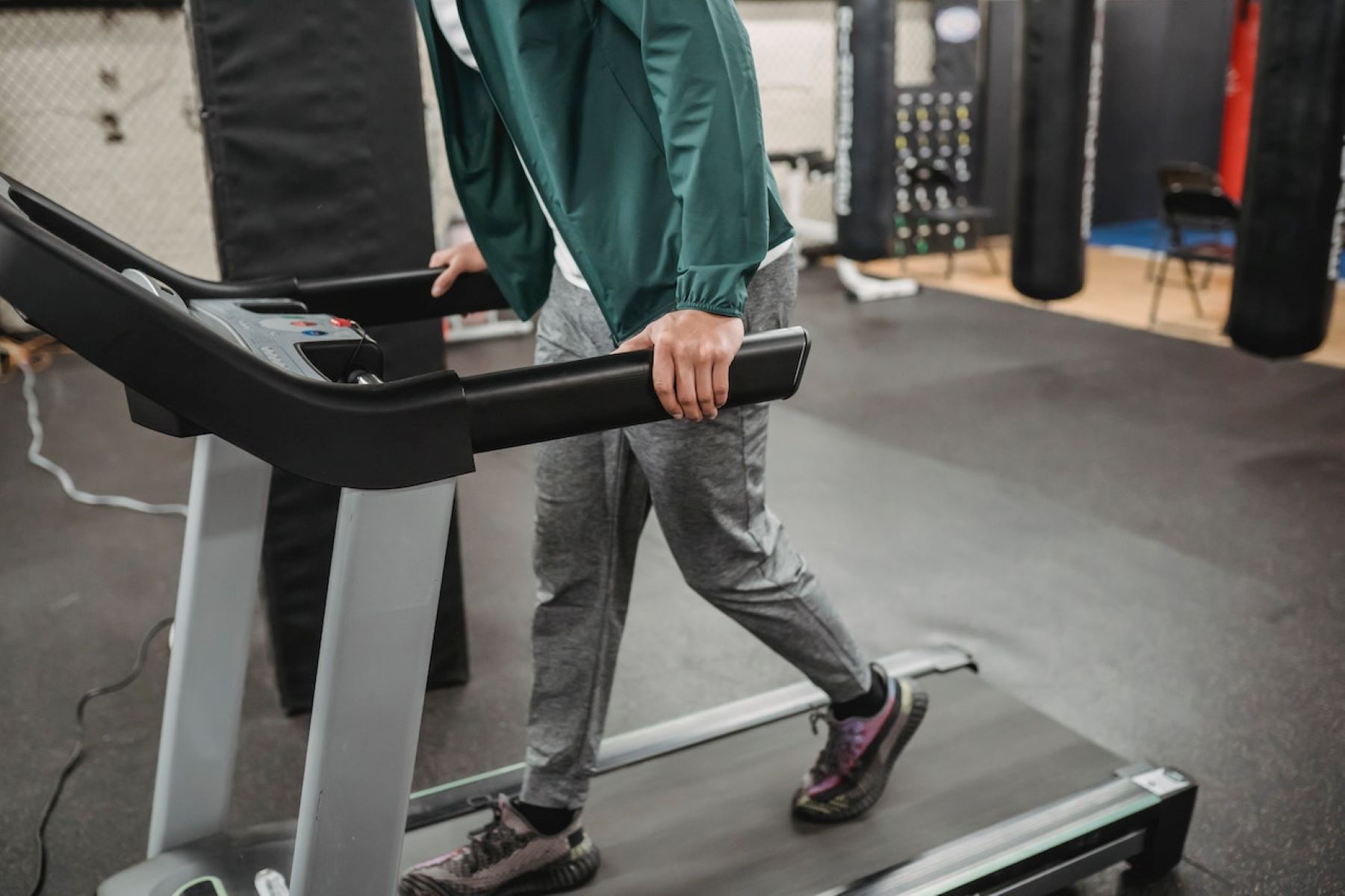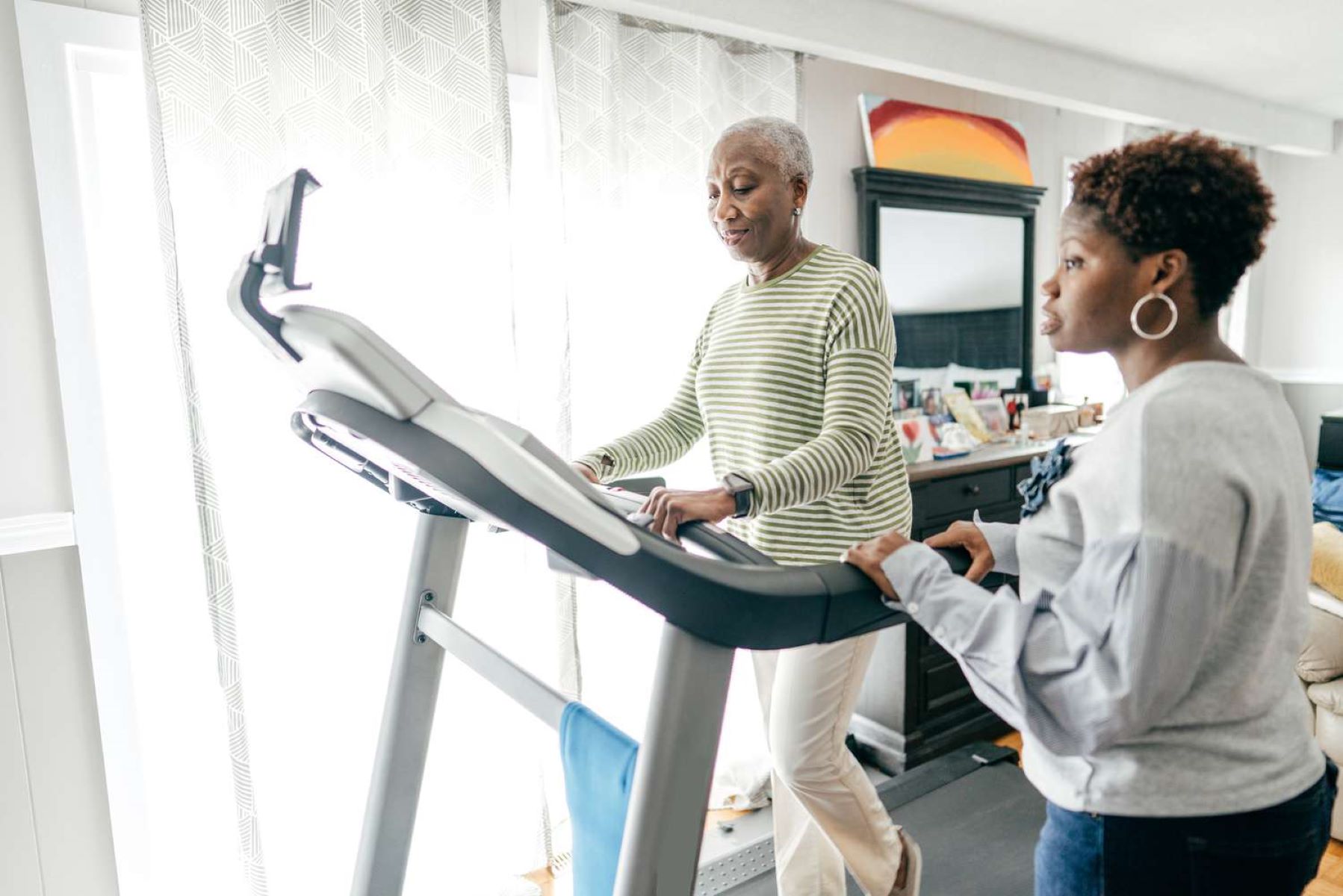

Featured
How Long To See Results From Treadmill
Modified: January 2, 2024
Discover how long it takes to see results from using a treadmill and get featured tips for maximizing your workout.
Introduction
Using a treadmill can be a great way to improve your fitness level, burn calories, and achieve your health goals. Whether you’re aiming to lose weight, improve your cardiovascular endurance, or tone your muscles, the treadmill can be a valuable tool in your fitness routine. However, it’s natural to wonder how long it will take to see results from your treadmill workouts.
The answer to this question varies from person to person and depends on several factors. It’s important to understand that fitness and health outcomes are not achieved overnight. Patience, consistency, and dedication to your treadmill workouts are key factors in determining how quickly you will see results.
In this article, we will explore the different factors that can affect the time it takes to see results from treadmill exercises. From your physical fitness level to the frequency and intensity of your workouts, we’ll cover everything you need to know to set realistic expectations and stay motivated on your fitness journey.
Factors Affecting Results
Several factors can influence the time it takes to see results from your treadmill workouts. Understanding these factors can help you set realistic expectations and make adjustments to your fitness routine as needed. Here are the key factors to consider:
- Physical Fitness Level: Your starting point plays a significant role in how quickly you’ll see results. If you’re already in good physical condition, you may notice improvements sooner compared to someone who is just starting their fitness journey. It’s essential to focus on gradual progression and listen to your body to avoid injury.
- Exercise Intensity and Duration: The intensity and duration of your treadmill workouts can affect how quickly you see results. Higher-intensity workouts, such as interval training or HIIT (high-intensity interval training), can yield faster results compared to lower-intensity steady-state cardio. Similarly, longer workout sessions may lead to quicker progress compared to shorter workouts.
- Frequency of Treadmill Sessions: Consistency is key when it comes to achieving results. Regularly engaging in treadmill workouts promotes continuous progress. Aim for a minimum of three to five sessions per week to see substantial improvements in your fitness level.
- Body Composition and Weight Loss: If weight loss is one of your goals, your body composition plays a vital role. While the treadmill can help burn calories and create a calorie deficit, weight loss is influenced by many factors, including diet, genetics, and overall lifestyle. It’s important to focus on overall health and body composition changes rather than just the number on the scale.
These are just a few of the factors that can impact the time it takes to see results from your treadmill workouts. Each person is unique, and various individual factors, such as genetics, metabolism, and lifestyle habits, can also play a role. It’s important to remember that consistency, patience, and a well-rounded approach to fitness are the keys to long-term success.
Physical Fitness Level
Your current physical fitness level is an important factor that affects how quickly you’ll see results from your treadmill workouts. If you’re already in good shape and have a decent level of cardiovascular endurance, you may experience faster progress compared to someone who is just starting their fitness journey.
If you’re new to exercise or have a lower fitness level, starting slowly and gradually increasing the intensity and duration of your treadmill workouts is key. This approach allows your body to adapt and avoid overexertion or injury. However, it’s important to challenge yourself and gradually push your limits to continue making progress.
As you become more physically fit, you may notice improvements in your stamina and the ability to sustain higher intensities for longer durations. Your cardiovascular system becomes more efficient, and you may experience a decrease in your resting heart rate. These changes are indicators of improved fitness and are signs that your treadmill workouts are yielding positive results.
Remember, everyone’s fitness journey is unique, and progress may vary. Listen to your body, pay attention to how you feel during and after your treadmill sessions, and make adjustments accordingly. Celebrate your small victories and continue striving for improvement, regardless of your starting point.
It’s worth noting that seeing physical changes in your body, such as toning and muscle definition, is not solely dependent on your fitness level or treadmill workouts. Incorporating strength training exercises and following a balanced diet are also important factors in achieving the desired physical transformations.
Ultimately, whether you’re a beginner or an experienced athlete, consistency is key. Stick to your treadmill workouts, challenge yourself, and keep track of your progress. With time and dedication, you’ll see improvements in your physical fitness level and reap the benefits of regular exercise.
Exercise Intensity and Duration
The intensity and duration of your treadmill workouts play a significant role in determining how quickly you’ll see results. Higher-intensity workouts and longer durations can lead to faster progress compared to lower-intensity or shorter workouts.
High-intensity interval training (HIIT) is known for its effectiveness in burning calories and improving cardiovascular fitness. This type of workout involves alternating periods of intense effort with periods of active recovery. HIIT workouts on the treadmill can be as short as 15-20 minutes but can deliver significant results in terms of calorie burn and cardiovascular conditioning.
Alternatively, if your goal is to improve endurance and stamina, longer duration workouts at a moderate intensity may be more suitable. Steady-state cardio sessions lasting 30-60 minutes can help increase your aerobic capacity and enhance your cardiovascular health.
It’s important to find the right balance between intensity and duration that suits your fitness level and goals. Pushing yourself too hard without allowing for adequate recovery can lead to burnout or injury. On the other hand, not challenging yourself enough may slow down your progress.
Remember to listen to your body and pay attention to how you feel during and after each workout. Gradually increase the intensity and duration of your treadmill sessions as your fitness level improves. This progressive overload approach ensures that you continue to challenge yourself and make consistent progress.
Varying your treadmill workouts can also be beneficial. Incorporating incline training, where you increase the slope of the treadmill, can help to intensify your workout and engage different muscle groups. Likewise, adding intervals of higher intensity bursts within your steady-state cardio can provide an added challenge and boost calorie burn.
Ultimately, the key is to find a balance that works for you and aligns with your fitness goals. Consistency is crucial, so find a sustainable intensity and duration that you can maintain over time. Enjoy the process, challenge yourself, and observe the positive changes that come with regular treadmill workouts.
Frequency of Treadmill Sessions
Consistency is vital when it comes to seeing results from your treadmill workouts. The frequency at which you engage in treadmill sessions directly impacts the rate at which you’ll see progress. Aim for a minimum of three to five sessions per week to optimize your fitness gains.
Regularly scheduled treadmill workouts allow your body to adapt and improve over time. Each session builds upon the previous one, creating a cumulative effect. By consistently challenging yourself, you signal to your body that it needs to adapt and become more efficient.
When deciding on your treadmill workout frequency, consider your current fitness level, time availability, and recovery needs. If you’re new to exercise or have a busy schedule, starting with three sessions per week and gradually increasing from there can be a realistic approach.
Keep in mind that the key is to find a frequency that is sustainable for you in the long run. It’s better to have consistently scheduled workouts three times a week than overdo it and have to take extended breaks due to burnout or injury.
It’s also important to balance your treadmill sessions with other types of exercise and rest days. Incorporating strength training exercises on non-treadmill days can help improve overall fitness and prevent muscle imbalances. Additionally, rest days allow your body to recover and rebuild, which is crucial for muscle growth and overall well-being.
Remember that progress happens over time, and there is no one-size-fits-all approach. Pay attention to how your body feels and adjust your frequency as needed. If you’re consistently challenging yourself and allowing for adequate rest, you’ll begin to notice improvements in your fitness level and overall well-being.
Body Composition and Weight Loss
If weight loss is one of your goals, it’s important to understand that the treadmill alone is not a magic solution. Achieving lasting weight loss requires a combination of regular exercise, a healthy diet, and overall lifestyle changes.
When it comes to body composition and weight loss, the treadmill can be a valuable tool. It can help create a calorie deficit by burning calories and increasing your overall energy expenditure. However, weight loss is impacted by various factors, including genetics, metabolism, diet, and lifestyle habits.
It’s important to focus on overall health and body composition changes rather than solely relying on the number on the scale. As you engage in regular treadmill workouts, you may experience a decrease in body fat percentage and an increase in muscle mass.
Keep in mind that muscle is denser than fat, so even if the number on the scale doesn’t change significantly, you may notice changes in how your clothes fit and in your body shape. It’s also worth noting that muscle tissue plays a crucial role in boosting metabolism, so increasing your muscle mass can help support long-term weight management.
In addition to treadmill workouts, incorporate strength training exercises to build muscle and increase your overall calorie burn. Combining cardio and strength training can help maximize calorie expenditure and enhance the effectiveness of your weight loss efforts.
Remember, weight loss is a gradual process, and it’s important to set realistic goals. Aim for a sustainable rate of weight loss, such as 1-2 pounds per week, as this is more likely to lead to long-term success.
Lastly, don’t forget the importance of a balanced diet. While the treadmill can help create a calorie deficit, it’s crucial to fuel your body with nutritious food to support your workouts and overall health. Consult with a registered dietitian or nutritionist to develop a meal plan that aligns with your goals.
Keep in mind that body composition and weight loss are multifaceted. Focus on developing healthy habits, making sustainable lifestyle changes, and celebrating non-scale victories along the way. With consistency and a holistic approach, you’ll experience positive changes in your body composition and overall well-being.
Cardiovascular Health Improvements
Regular treadmill workouts can significantly improve your cardiovascular health and overall fitness level. Cardiovascular exercise, also known as aerobic exercise, is any activity that increases your heart rate and makes you breathe harder. The treadmill provides a convenient and effective way to engage in cardiovascular exercise.
Engaging in treadmill workouts can have several positive effects on your cardiovascular health:
- Heart Strength: Regular cardiovascular exercise, such as treadmill workouts, helps strengthen your heart muscles. As you consistently challenge your heart with aerobic activity, it becomes more efficient at pumping blood and delivers oxygen-rich blood to your muscles more effectively.
- Lowers Blood Pressure: Regular aerobic exercise has been shown to lower blood pressure levels in individuals with hypertension. By engaging in treadmill workouts, you can help lower your blood pressure and reduce the risk of cardiovascular diseases.
- Improves Blood Flow: Treadmill workouts increase blood circulation throughout your body. This improved blood flow helps deliver oxygen and nutrients to your muscles and organs, promoting their overall health and function.
- Increases Stamina and Endurance: Regular treadmill sessions improve your stamina and endurance by challenging your cardiovascular system. Over time, you’ll notice that you have more energy throughout the day and can engage in physical activities without getting tired as quickly.
- Reduces the Risk of Cardiovascular Diseases: Engaging in regular cardiovascular exercise, including treadmill workouts, has been linked to a lower risk of developing various cardiovascular diseases, such as heart disease and stroke. It helps in maintaining healthy cholesterol levels, reducing inflammation, and managing weight.
Remember, consistency is key when it comes to reaping the cardiovascular benefits of treadmill workouts. Start slowly if you’re new to exercise and gradually increase the intensity and duration of your sessions. Aim for at least 150 minutes of moderate-intensity aerobic exercise or 75 minutes of vigorous-intensity aerobic exercise per week, as recommended by health authorities.
It’s important to note that if you have any preexisting cardiovascular conditions or concerns, consult with your healthcare provider before starting a new exercise regimen. They can provide guidance and tailored recommendations to ensure your safety and well-being.
By incorporating regular treadmill workouts into your routine, you’ll experience improved cardiovascular health, increased endurance, and a reduced risk of cardiovascular diseases. Enjoy the benefits of a stronger heart and an overall healthier body as you continue on your fitness journey.
Muscle Toning and Strengthening
The treadmill is often associated with cardiovascular exercise, but it can also be a valuable tool for muscle toning and strengthening. While running or walking on a treadmill primarily targets the muscles in your lower body, it can still provide significant benefits for overall muscle development.
Here are some ways in which treadmill workouts can contribute to muscle toning and strengthening:
- Leg Muscles: Running or walking on a treadmill engages the muscles in your legs, including your quadriceps, hamstrings, calves, and glutes. These muscles work together to propel you forward and support your body weight.
- Core Activation: Your core muscles, including the abdominals and lower back, play a crucial role in maintaining stability and balance during treadmill workouts. The act of running or walking on the treadmill requires your core muscles to engage and stabilize your body, resulting in improved core strength and toning.
- Arms and Upper Body: Although the treadmill primarily focuses on the lower body, you can incorporate arm movements by using the treadmill’s handrails or incorporating upper body exercises, such as bicep curls or shoulder presses, during your workout. These additional movements engage the muscles in your arms, chest, and upper back.
- Incline Training: One of the benefits of using a treadmill is the ability to adjust the incline. Running or walking on an incline targets different muscle groups, such as your glutes and calves, more intensely. Incorporating incline training into your treadmill workouts can add variety and help strengthen and tone additional muscles.
- High-Intensity Interval Training (HIIT): HIIT workouts on the treadmill, which involve alternating between intense bursts of effort and periods of recovery, can help promote muscle growth and toning. The short bursts of high-intensity activity challenge your muscles and stimulate muscle growth.
It’s important to note that for significant muscle building, incorporating strength training exercises that target individual muscle groups is essential. However, treadmill workouts can still contribute to overall muscle toning and strength when combined with a comprehensive fitness routine.
Additionally, it’s worth mentioning that muscle toning and strengthening are not solely dependent on the treadmill. Proper nutrition, sufficient rest, and a well-rounded exercise program that includes strength training exercises are important for achieving optimal results. A balanced approach to fitness and incorporating a variety of exercises into your routine can help you achieve total body strength and toning.
As with any exercise program, it’s important to start at a comfortable intensity and gradually increase as your muscles adapt. Focus on maintaining good form and technique while performing treadmill exercises to ensure maximum effectiveness and minimize the risk of injury.
Through consistency, proper form, and a well-rounded fitness routine, your treadmill workouts can contribute to improved muscle tone, strength, and overall body composition.
Mental and Emotional Benefits
The benefits of treadmill workouts extend beyond physical fitness. Engaging in regular exercise on a treadmill can have significant positive impacts on your mental and emotional well-being. Here are some of the mental and emotional benefits you can gain from incorporating treadmill workouts into your routine:
- Stress Relief: Exercise, including treadmill workouts, has been shown to reduce stress levels. Physical activity stimulates the release of endorphins, which are natural mood-boosting chemicals in the brain. This can help alleviate stress, anxiety, and improve overall mental well-being.
- Mood Enhancement: Treadmill workouts can enhance your mood and promote feelings of happiness. Exercise has been shown to increase the production of serotonin and dopamine, which are neurotransmitters responsible for regulating mood. Regular exercise can help combat feelings of depression and improve overall mental clarity and focus.
- Boost in Energy Levels: Treadmill workouts can increase your overall energy levels. Engaging in physical activity increases blood flow and oxygen delivery throughout the body, resulting in a boost in energy and mental alertness. Regular exercise can help combat feelings of fatigue and improve productivity throughout the day.
- Improved Sleep: Regular treadmill workouts can help promote better sleep quality. Exercise has been shown to regulate sleep patterns, enhance deep sleep, and reduce the time it takes to fall asleep. However, it’s important to avoid intense workouts close to bedtime, as it may interfere with sleep for some individuals.
- Increased Confidence and Self-esteem: Consistently engaging in treadmill exercises and making progress in your fitness goals can boost self-confidence and self-esteem. Achieving milestones, such as increasing your workout duration or running at a faster pace, can give you a sense of accomplishment and improve your overall self-perception.
- Opportunity for Self-care: Taking the time for treadmill workouts provides an opportunity for self-care and self-reflection. It allows you to focus on yourself, disconnect from daily stressors, and invest in your physical and mental well-being. This dedicated time for yourself can promote a sense of calm and improve your overall outlook on life.
Remember, exercise is not a substitute for professional mental health care. If you’re experiencing severe mental health issues, it’s important to seek guidance from a healthcare professional. However, incorporating regular treadmill workouts as part of your overall self-care routine can contribute to improved mental and emotional well-being.
Make your treadmill workouts enjoyable by adding music, podcasts, or audiobooks to keep yourself motivated. Consider varying your workouts by incorporating different workout programs or exploring virtual running apps that simulate outdoor environments.
By recognizing the mental and emotional benefits of treadmill workouts, you can transform your exercise routine into a multifaceted approach that supports your overall well-being.
Conclusion
The treadmill can be a valuable tool in your fitness journey, offering a range of benefits for your physical, mental, and emotional well-being. While the time it takes to see results from treadmill workouts varies from person to person, several factors can influence the pace of your progress.
The key factors that can affect the time it takes to see results include your physical fitness level, exercise intensity and duration, frequency of treadmill sessions, body composition and weight loss goals, cardiovascular health improvements, and muscle toning and strengthening.
It’s important to set realistic expectations and focus on the journey rather than solely on the end results. Celebrate small victories along the way, such as increased endurance, improved mood, and enhanced overall well-being.
Remember to listen to your body, adjust your workouts as needed, and incorporate a balanced approach to fitness that includes both cardiovascular exercise on the treadmill and strength training exercises. Additionally, prioritize rest and recovery to prevent injuries and optimize muscle growth and repair.
Above all, consistency and dedication are key. Stay committed to your treadmill workouts, make them enjoyable by incorporating music or entertainment, and view them as an opportunity for self-care and personal growth.
By understanding the factors affecting your progress and maintaining a positive mindset, you can make the most of your treadmill workouts and achieve your fitness goals in a sustainable and rewarding manner.









